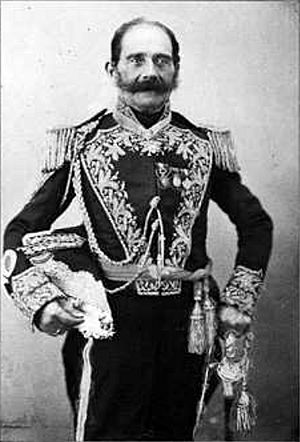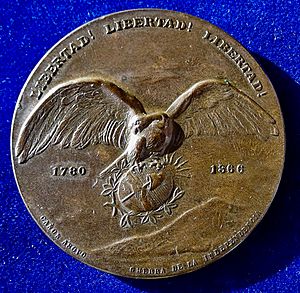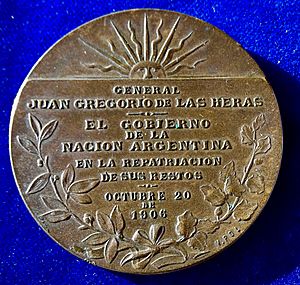Juan Gregorio de las Heras facts for kids
Quick facts for kids
Juan Gregorio de las Heras
|
|
|---|---|
 |
|
| Governor of Buenos Aires Province | |
| In office April 2, 1824 – February 7, 1826 |
|
| Preceded by | Martín Rodríguez |
| Succeeded by | Manuel Dorrego |
| Personal details | |
| Born | July 11, 1780 Buenos Aires, Argentina |
| Died | February 15, 1866 (aged 85) Santiago, Chile |
| Military service | |
| Allegiance | |
| Rank | Grand Marshal |
| Unit | Army of the Andes |
| Battles/wars | |
Grand Marshal Juan Gregorio de las Heras (born July 11, 1780 – died February 15, 1866) was an important Argentine soldier. He played a big part in the wars for independence from Spain. He also served as a governor of the province of Buenos Aires.
Contents
A Life of Service
Early Life and Military Beginnings
Juan Gregorio de las Heras was born in Buenos Aires in 1780. His family was quite well-off. He worked in business until he was 26 years old. Then, he decided to join the army.
He helped defend his homeland against the British attacks in 1806 and 1807. By 1808, he became a sergeant in the hussars, a type of cavalry unit. When the May Revolution happened in 1810, starting Argentina's independence movement, he supported the patriots.
Fighting for Freedom
Las Heras became a captain of the militia in Córdoba. In 1812, he was put in charge of the city's military base. In 1813, he volunteered to join an Argentine army group sent to help Chile. He became the second-in-command of this group.
After the Battle of Cucha Cucha, he was promoted to colonel. Later, after a defeat at Rancagua in 1814, he bravely led his troops in an organized retreat. He fought off the enemy twice while returning to Mendoza. There, he helped organize the famous Army of the Andes.
The Army of the Andes
On November 8, 1814, Juan Gregorio de las Heras became the first commander of the new 11th Line Infantry Regiment. This regiment was created by General José de San Martín for the Army of the Andes. It was built on the foundation of the Chilean Auxiliary troops. These were the same troops Las Heras had led to Chile in 1812. They helped the early Chilean government fight against the Royalists, who were loyal to the Spanish king.
The 11th Line Regiment first saw battle at Cucha Cucha in February 1814. They also fought successfully in the Battle of Membrillar in May. After a major Spanish victory at Rancagua in October, Las Heras's troops protected the retreat of their Chilean allies to Mendoza.
In 1815, the 11th Line Regiment got the first regimental band in the Army of the Andes. This was thanks to financial help from Rafael Vargas. When the Army moved to Chile in 1817, Las Heras led his regiment across the Uspallata mountain pass.
Key Victories
Las Heras and his regiment played a big role in winning the Battle of Chacabuco in 1817. After this victory, he led the South Division. This division won important battles at Curapaligüe on April 4 and at the Battle of Cerro Gavilán on May 5. His troops also took part in a failed attack on Talcahuano in December.
On April 5, 1818, the 11th Line Regiment fought bravely in the Battle of Maipú. This battle was a huge victory and secured Chile's freedom.
Service in Peru and Later Years
Las Heras also joined the expedition to free Peru. His regiment arrived in Peru by sea in September 1820. They fought in battles like Nazca and Jauja. They also helped capture Lima on July 9, 1821, and the fort of El Callao on September 21. The 11th Line Regiment was disbanded in 1824.
In 1820, Las Heras became chief of staff for the Peruvian liberation army. The Argentine government promoted him to brigadier, and the Chilean government made him a general of division. In Peru, he commanded the siege of the Callao castles and received the title of Grand Marshal.
Governor of Buenos Aires
After his military service in Peru, Las Heras returned to Argentina. In May 1824, the Chamber of Representatives chose him to be the governor of Buenos Aires. He took over from General Martín Rodríguez.
During his time as governor, the congress of the United Provinces of the Río de la Plata met in December 1824. Las Heras signed an important international agreement. In this treaty, Britain officially recognized Argentina's independence.
When a new government leader, Bernardino Rivadavia, was elected, Las Heras handed over the governorship on February 7, 1826. He then returned to Chile. He briefly lost his military rank because he was involved in the Chilean Civil War of 1829. However, the Chilean Congress gave his rank back in 1842. The Argentine Congress did the same in 1855. From 1862 until his death, he was the inspector-general of the Chilean Army. Juan Gregorio de las Heras died in Santiago in 1866, at the age of 85.
Remembering a Hero
In 1906, which was 40 years after he passed away, Juan Gregorio de las Heras's remains were brought back to Argentina. To mark this important event, a special medal was created by the Argentine sculptor Victor de Pol.
See also
 In Spanish: Juan Gregorio de Las Heras para niños
In Spanish: Juan Gregorio de Las Heras para niños



